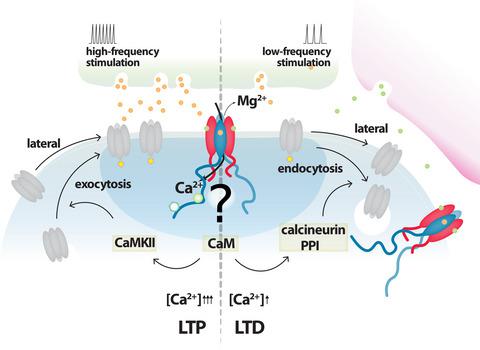当前位置:
X-MOL 学术
›
Eur. J. Neurosci.
›
论文详情
Our official English website, www.x-mol.net, welcomes your
feedback! (Note: you will need to create a separate account there.)
The C-terminal domains of the NMDA receptor: How intrinsically disordered tails affect signalling, plasticity and disease
European Journal of Neuroscience ( IF 2.7 ) Pub Date : 2020-05-28 , DOI: 10.1111/ejn.14842 Xavier L Warnet 1, 2, 3 , Helle Bakke Krog 1, 2, 3 , Oscar G Sevillano-Quispe 1, 2, 3 , Hanne Poulsen 1, 2, 3 , Magnus Kjaergaard 1, 2, 3
European Journal of Neuroscience ( IF 2.7 ) Pub Date : 2020-05-28 , DOI: 10.1111/ejn.14842 Xavier L Warnet 1, 2, 3 , Helle Bakke Krog 1, 2, 3 , Oscar G Sevillano-Quispe 1, 2, 3 , Hanne Poulsen 1, 2, 3 , Magnus Kjaergaard 1, 2, 3
Affiliation

|
NMDA receptors are part of the ionotropic glutamate receptor family, and are crucial for neurotransmission and memory. At the cellular level, the effects of activating these receptors include long-term potentiation (LTP) or depression (LTD). The NMDA receptor is a stringently gated cation channel permeable to Ca2+, and it shares the molecular architecture of a tetrameric ligand-gated ion channel with the other family members. Its subunits, however, have uniquely long cytoplasmic C-terminal domains (CTDs). While the molecular gymnastics of the extracellular domains have been described in exquisite detail, much less is known about the structure and function of these CTDs. The CTDs vary dramatically in length and sequence between receptor subunits, but they all have a composition characteristic of intrinsically disordered proteins. The CTDs affect channel properties, trafficking and downstream signalling output from the receptor, and these functions are regulated by alternative splicing, protein–protein interactions, and post-translational modifications such as phosphorylation and palmitoylation. Here, we review the roles of the CTDs in synaptic plasticity with a focus on biochemical mechanisms. In total, the CTDs play a multifaceted role as a modifier of channel function, a regulator of cellular location and abundance, and signalling scaffold control the downstream signalling output.
中文翻译:

NMDA 受体的 C 端结构域:内在无序的尾巴如何影响信号、可塑性和疾病
NMDA 受体是离子型谷氨酸受体家族的一部分,对神经传递和记忆至关重要。在细胞水平上,激活这些受体的作用包括长时程增强 (LTP) 或抑制 (LTD)。NMDA 受体是一个严格门控的阳离子通道,可渗透 Ca 2+,并且它与其他家族成员共享四聚体配体门控离子通道的分子结构。然而,它的亚基具有独特的长细胞质 C 端结构域 (CTD)。虽然细胞外结构域的分子体操已被详细描述,但对这些 CTD 的结构和功能知之甚少。CTD 的长度和受体亚基之间的序列差异很大,但它们都具有固有无序蛋白质的组成特征。CTD 影响受体的通道特性、运输和下游信号输出,这些功能受选择性剪接、蛋白质-蛋白质相互作用和翻译后修饰(如磷酸化和棕榈酰化)的调节。这里,我们回顾了 CTD 在突触可塑性中的作用,重点是生化机制。总的来说,CTD 作为通道功能的调节剂、细胞位置和丰度的调节剂,以及信号支架控制下游信号输出,发挥着多方面的作用。
更新日期:2020-05-28
中文翻译:

NMDA 受体的 C 端结构域:内在无序的尾巴如何影响信号、可塑性和疾病
NMDA 受体是离子型谷氨酸受体家族的一部分,对神经传递和记忆至关重要。在细胞水平上,激活这些受体的作用包括长时程增强 (LTP) 或抑制 (LTD)。NMDA 受体是一个严格门控的阳离子通道,可渗透 Ca 2+,并且它与其他家族成员共享四聚体配体门控离子通道的分子结构。然而,它的亚基具有独特的长细胞质 C 端结构域 (CTD)。虽然细胞外结构域的分子体操已被详细描述,但对这些 CTD 的结构和功能知之甚少。CTD 的长度和受体亚基之间的序列差异很大,但它们都具有固有无序蛋白质的组成特征。CTD 影响受体的通道特性、运输和下游信号输出,这些功能受选择性剪接、蛋白质-蛋白质相互作用和翻译后修饰(如磷酸化和棕榈酰化)的调节。这里,我们回顾了 CTD 在突触可塑性中的作用,重点是生化机制。总的来说,CTD 作为通道功能的调节剂、细胞位置和丰度的调节剂,以及信号支架控制下游信号输出,发挥着多方面的作用。











































 京公网安备 11010802027423号
京公网安备 11010802027423号